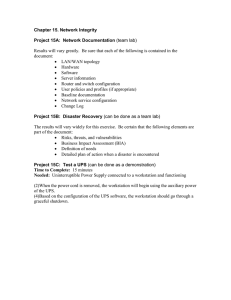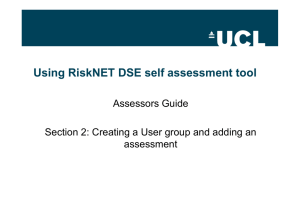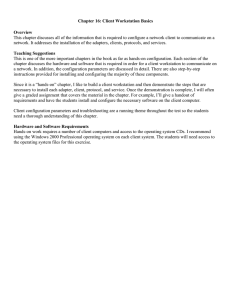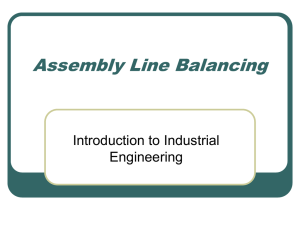37 THE PRECIS OF PROJECT
advertisement
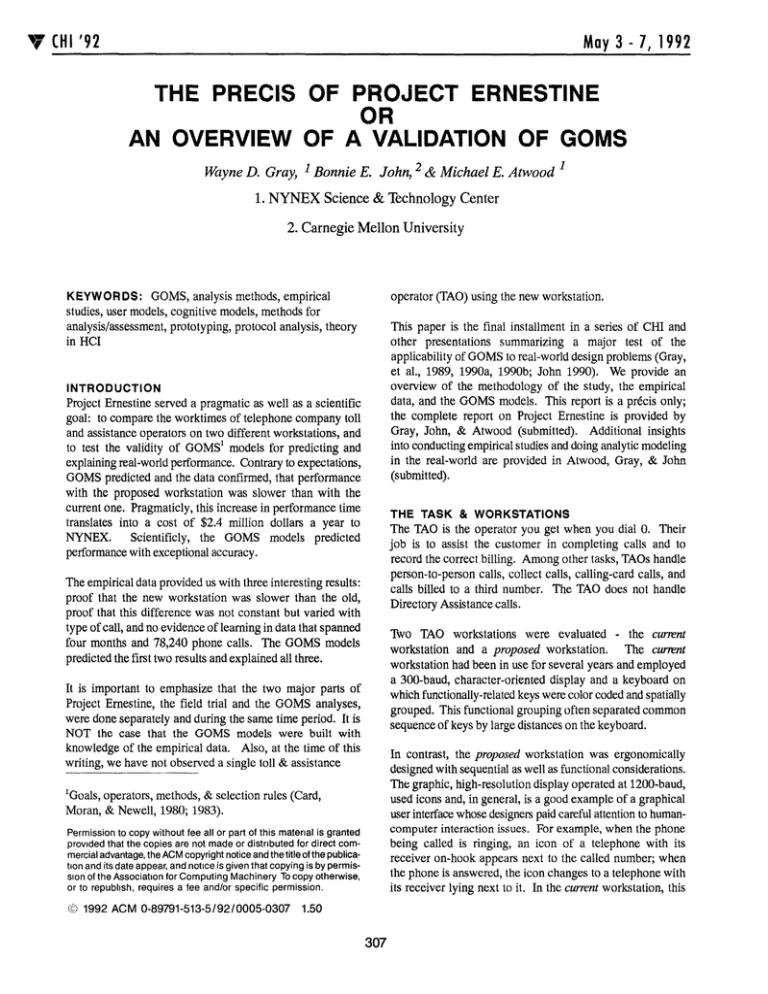
37 CHI’92 May 3-7, THE PRECIS OF PROJECT ERNESTINE OR OF A VALIDATION OF GOMS AN OVERVIEW Wayne D. Gray, 1 Bonnie 1. NYNEX KEYWORDS: E. John, 2 & Michael Science 2. Carnegie & Technology Mellon GOMS, analysis methods, empirical studies, user models, cognitive analysis/assessment, E. Atwood 1 Center University operator (TAO) using the new workstation, models, methods for prototyping, protocol analysis, theory This paper is the final installment in HCI other presentations applicability Project Ernestine served a pragmatic to compare the worktimes as well as a scientific workstations, a major of GOMS to real-world the complete of telephone company toll and assistance operators on two different in a series of CHI and summarizing test of the design problems (Gray, et al., 1989, 1990a, 1990b; John 1990). We provide an overview of the methodology of the study, the empirical data, and the GOMS models. This report is a pr6cis only; INTRODUCTION goal: 1992 report on Project Gray, John, & Atwood and Ernestine (submitted). is provided Additional by insights to test the validity of GOMSl models for predicting and explaining real-world performance. Contrary to expectations, into conducting empirical studies and doing analytic modeling in the real-world are provided in Atwood, Gray, & John GOMS predicted and the data confirmed, (submitted). with the proposed workstation that performance was slower than with the current one, Pragmaticly, this increase in performance time translates into a cost of $2.4 million dollars a year to NYNEX. Scientificly, the GOMS performance with exceptional accuracy. The empirical proof models that the new workstation record the correct billing. was slower person-to-person results: calls billed than the old, Directory was not constant but varied with type of call, and no evidence of learning in data that spanned four months and 78,240 phone calls. The GOMS Two models to emphasize Project Ernestine, to a third number. calls, and The TAO does not handle workstations were and a proposed evaluated workstation. - the current The curnmt had been in use for several years and employed a 300-baud, character-oriented display and a keyboard on which functionally-related keys were color coded and spatially analyses, grouped. were done separately and during the same time period. It is NOT the case that the GOMS models were built with knowledge of the empirical data. Also, at the time of this writing, — TAO workstation that the two major parts of the field trial and the GOMS Among other tasks, TAOS handle calls, collect calls, calling-card Assistance calls. workstation predicted the first two results and explained all three. It is important & WORKSTATIONS The TAO is the operator you get when you dial O. Their job is to assist the customer in completing calls and to predicted data provided us with three interesting proof that this difference THE TASK This functional grouping often separated common sequence of keys by large distances on the keyboard. In contrast, we have not observed a single toll & assistance the proposed workstation was ergonomically designed with sequential as well as functional The graphic, high-resolution considerations. display operated at 1200-baud, lGoals, operators, methods, & selection rules (Card, used icons and, in general, is a good example of a graphical Moran, & Newell, user interface whose d~signers paid careful attention to humancomputer interaction issues. For example, when the phone being called is ringing, an icon of a telephone with its receiver on-hook appears next to the called number; when the phone is answered, the icon changes to a telephone with 1980; 1983). Permission to copy without fee all or part of this material is granted prowded that the copies are not made or distributed for direct commercial advantage, the ACM copyright notice and the title of the publication and its date appear, and notice is given that copying is by permission of the Association for Computing Machinery To copy otherwise, or to repubhsh, requires a fee and/or specific permission. @ 1992 ACM 0-89791-513-5 /92/0005-0307 its receiver lying next to it. In the current workstation, 1.50 307 this [HI ’92 Mav 3-7, is indicated by the ASCII charactem “CLD CalLeD of 78,240 calls. 1“ (standing for Five call categories some analyses due to insufficient line 1) appearing far away from the called number, were eliminated occurrence 1992 for of those call in the lower part of the screen, Similar care went into the design of the keyboard, where an effort was made to minimize categories. travel distance among the most frequent key sequences and to reduce the number of keystrokes required to complete a Collapsing over call category to look at the median work time per call for each participant, for each month, the data call by replacing show that the proposed function common two-key sequences with a single group is slower current workstation. THE FIELD TRIAL and financially This 0.8 seconds is both statistically significant. The 0.8 second deficit translates into a cost of $2.4 million Methodology a year in additional costs if the proposed workstation Participants the NYNEX The phone company operating were to be installed across operating mea. office used in the study employs over 100 TAOS and handles traffic area. than the curwnt group by 4Yo; that is, the proposed workstation requires 0.8 seconds more time on an average call than does the key. For purposes in the Boston, Massachusetts Reflecting of the study, 12 current workstations were removed and 12proposed workstations seasonal variations of month installed. is significant, by month. in call-mix, This lack of a significant (NETj of two quickly, reaching performance suggests mastered it very within the first month of performance. years. Twenty-four participants were selected for theprcymsed workstations (the proposed condition) from a list of For the analysis approximately sufficiently 60 volunteem. asymptotic of groups interaction that TAOS using the proposed workstation All participants were New England ‘lMephone employees who had worked as TAOS for a minimum the main effect but not the interaction Each proposed participant by call category we looked represented call categories, at the 15 This analysis yielded was paired with a control participant matching for shift worked (that is, time of day), and average worktime on the significant effects of group, call category, and their interaction. The effect of call category was expected due to the different current workstation nature of the calls. The interaction shows that the advantage of the current workstation over the proposed is not constant (the current condition). were taken from data routinely TAO worktimes collected by office managers for the six months prior to the start of the trial (while both for all call categoriw. For some call categories this difference is small (0,2 seconds) while for others it is quite large (3.7 groups were using the current workstation). seconds). This is an interesting result that cannot be explained by the field data. This is a result on which analytic models Trial Procedures Proposed and current participants during the four month proposed participants identical trial. may shed much light. worked their normal shifts From the perspective of the their tasks and duties as a TAO were ANALYTIC MODELING to their pretrial job in all respects but one; namely, Benchmark Tasks a new workstation was used. For the cumnt participants nothing had changed. To obtain our data, we extracted the Rather than model every possible procedure executed by the calls handled by our 24proposed TAOS, for each call category we modeled one common, or important, variation. With the help of NYNEX Operator from a NYNEX and 24 curn?nt participants database that routinely samples one out of every ten calls. Services personnel, we wrote a single script for each of the Call Categories as benchmarks. were validated against To concentrate our effort for both the empirical and analytic comparisons we decided to focus on calls categories that were either high volume or of special interest to NYNEX observed calls and were found to be representative average work time for these call categories. of the 20 call categories originally Operator Services. The final list of 20 call categories accounted for 88.33~0 of all completed calls. This percentage is based upon one month’s frequency data for all calls handled by all NET TAOS. chosen for study and used these These benchmarks The GOMS Models To model these benchmarks, ‘Note: additional statistical two different approaches were analysis, as well as details of those reported here are available in Gray et al., submitted, Results For the 48 TAOS (24proposed 3The level of significance and 24 curwzl) over the four .05. months of the study, the 20 call categories sampled a total 308 choosen for this report isp e ~ May 3-7, [HI ’92 used: observation-based models. models upon videotapes of experienced each of the benchmark the analysis and specification-based The models of thecurnent workstation were based TAOS handling calls for tasks. In contrast, TAOS were never for the proposed workstation 1992 has 10 fewer boxes than the analysis for the curnmt, representing fewer keystrokes. on the critical two Second, none of the deleted boxes were path, all were performed in slack time. At observed using the proposed workstation. Rather, these models were specification-ba,s~, that is, they were constructed based upon system response time estimates and TAO this point in the task the critical path is determined by the TAO greeting and getting information from the customer. procedures provided by the manufacturer. nothing Removing keystrokes is controlled TAO’s do several customer’s perceive things in parallel when processing a that occur to affect the TAO’s by the conversation, not by the ergonomics during not by the keystrokes and of the keyboard. request: they listen or talk to the customer, they For theproposed workstation one of the keystrokes eliminated information on the CRT screen, they move their hands to appropriate keys and strike them. To display these at the beginning of the call (Figure and calculate total task times, we use the the call (Figure 2). parallel activities critical path method Because this extension Perception, Method, and Motor (developed for project management). distinguishes between Cognition, operators and uses the Critical we call it CPM-GOMS Path (John, 1988). CPM-GOMS represented activity the parallelism of the TAO’s in a schedule chart (Figures in handling associated duration. a call is represented Dependencies task 1 and 2). is activities are represented as lines connecting the boxes. For example, the TAO cannot hit the collect-billing key until s/he hears the customer request a collect call, Therefore, there is a dependency line drawn between the box representing the perception of the word “collect” and the boxes representing operators that verify the word “collect” the collect-billing key. the cognitive and initiate pressing The boxes and their dependency lines are drawn according to a detailed understanding TAO’s task, goal decomposition, heuristics complex of the and operator-placement (John, 1990). An important occur in parallel, the total task time for tasks is the criticalpath. When activities one sequence of activities time than parallel sequences of activities; will take more the critical goes time required for this keystroke now adds to the time required to process this call and CPM-GOMS predicts that, for this one less keystroke than the curnmt, the proposed will require more time. CPM-GOMS Predictions versus path is the Trial Data After four months of real-world use, during which we sampled 78,240 calls, the trial data showed that the proposed workstation was 4% slower that the cunent. Was this result predicted by the CPM-GOMS models? fact that the trial result was surprising, When each of the 15 call categories frequency of occurrence models predict that the proposed curwnt workstation. observed work Despite the the answer is yes. is weighted by its in the trial data the CPM-GOMS Looking will be 370 slower than at each of the 15 call categories that were analyzed, the correlation concept in analyzing parallel the keystroke from being performed during slack time, to being performed on the critical path. As a result, the cognitive and motor Each as a box with an between 1) now occurs later in In this analysis, call category, despite requiring In slack time does work time; that is, work time between times was significant predicted and for both the cumnt, r’=0.69, and the proposed workstation, r2=0.65, showing that the models adequately reflected the variation in work time as a function of call type. the sequence of activities that takes the longest and determines the total time for the entire task. The critical path is Models as Explanation displayed in boldface in Figures 1 &2. Including Each schedule chart is the CPM-GOMS Ernestine had one welcome, but unanticipated result. The trial data were so countcrintuitive that, in the absence of a model of the call it depicts. We constructed 30 such models, yielding performance predictions for the 15 benchmarks on the current workstation and the 15 benchmarks on the propased workstation, corresponding to the 15 call categories analymd in the empirical data. Workstation design features and call handling procedures have an impact on the length or a call whicn are reflected in the critical path, For example, Figures 1 and 2 show the first and last segments of a CPM-GOMS analysis for one 15 second calling-card call for both the current andproposed workstations. FigUre 1 has two striking features. First, the CPM-GOMS modeling effort in Project compelling explanation as to why the proposed workstation was slower than the cunent, there was a tendency to try to find fault with the trial rather than with the workstation. The manufacturer had predicted that theproposed workstation would be, on average, 2 seconds faster than the curwzt Given the general expectation that an workstation. ergonomically engineered, tIIOderII workstation should be faster than a five year old, ergonomically indifferent one, this estimate seemed reasonable, When the trial data began to accumulate, the immediate and widely-held conclusion was that something (training, procedures, or equipment) [Hi ’92 May 3-7, ... .-. ...... .... operators removed from slack time ... ... .......... Figure 1. Section of CPM-GOMS workstation analysis from near the beginning of the call. Notice that the proposed (bottom) has removed two keystrokes (which had required 7 motor and 3 cognitive this part of the call. However, operators) from none of the ten operatom removed were along the critical path (shown in bold). Current Workstation .. . .. . . ,=.. ..**** .. . .. . .. ..- . .. . .. Proposed operators critical added Workstation to path ,,.,.,.:.:.,.:.,.,.:.:.: ,.:,.,.,.: ,.:.:.:. +., ....... .,. . . ....* .. . .. . .. . .. . ... .. Figure 2. Section of CPM-GOMS ,..,:::, ..................... .~, :, :,.:.:.:. ,,,, ,,,, ,.,, ,,:.................... analysis from the end of the call. Notice that the proposed workstation (bottom) has added one keystroke to this part of the call which results in four operators (3 motor and 1 cognitive being added to the critical path (shown in bold). 310 1992 (H1 ’92 May 3-7, Office was wrong with the trial. of Naval Contract An initial model of just one call category (Gray conclusions et al., on the critical path, rather the length than in the slack of the call. close spacing of the function In addition, keys on theproposed predicted that this would be slower than the Also, while the workstation workstation was in displaying in outpulsing large faster than cumnt a whole screen of information numbers of digits key) faster. (as in a 14-digit slower than explaining validates real-world field data GOMS saved the day by We believe this study models for evaluating systems. Further, this study indicates that GOMS to reduce worktime. Esch, New York, NY (212) 636-6464 A. (1983). The interaction. Gray, W. D., John, B. E., Stuart, R., Lawrence, D., & Atwood, M. E. (1990b). GOMS meets the phone company: Analytic modeling applied to real-world problems. In D. Diaper, D, Gilmore, G. Cockton, and B. Shackel (Eds.), Human-Computer Interaction -- INTERACT ’90. North-Holland Elsevier Science Publishers. ACKNOWLEDGEMENTS Sandy Center, Gray, W. D,, John, B. E., Stuart, R., Lawrence, D., & Atwood, M. E. (1990a, May). GOMS meets the Part 2, o~ Data from the phone company: application of world’s first, large-scale G OMS. Poster presented at: CHI ’90, ACM SIGCI-WS Conference on Human Factors in Computing Systems. Seattle, WA. or runnings ystems. it interacts with the others, is unlikely Karen O’Brien, at Lincoln design ideas in lieu of empirical prototypes The CPM-GOMS models enable us to see the forest rather than the trees. We now understand the TAO’s task as a complex interaction involving the TAO, the customer, and various hardware and software. Trying to optimize one component of this interaction, without understanding how We thank University Gray, W. D., John, B. E., Lawrence, D., Stuart, R., & Atwood, M. E. (May 1989). GOMS meets the phone company, or, Can 8,400,000 unit-tasks be wrong? Poster presented at: CHI ’89, ACM SIGCHI’S Conference on Human Factors in Computing Systerrts. Austin, TX. result of new technology the usefulness of GOMS studies requiring Fordham Gray, W. D., John, B, E., & Atwood, M. E. (submitted). Validating GOMS for Project Ernestin e: Predicting and Explaining Real- World Task Performance In addition, when the empirical why this result occurred. can be used to evaluate should be are not on models predicted the empirical old technology, information Wayne D. Gray, Graduate School of Education, Card, S. K., Moran, T P., & Newell, psychology of human-computer Hillsdale, NJ: Erlbaum. the critical path but provides a deficit when they are. data yielded the counter-intuitive and additional sent to: Card, S. K., Moran, T. P., & Newell, A. (1980). Computer text editing: An information processing analysis of a routine cognitive skill. Cognitive Psychology, 12, 32-74. reduces the time to move from key to key does not provide a work time advantage when those movements accuracy. the of the Office Since many of these system Better designed displays provide no advantage to the TAO who knows what information to look for and where it will be displayed. Similarly, a better designed keyboard that with remarkable are those of the as representing Atwood, M. E., Gray, W. D., & John, B. E. (submitted). Analytic and Empirical Project Ernestine: Methods Applied to a Real-World CHI Problem. event are on the critical path, they add to the average worktime of the proposed workstation. CONCLUSION The CPM-GOMS Program, The view and REFERENCES or calling card number), the current workstation begins displaying information sooner and outpulses a single digit (as for a function in this document 10023. gray@mary.fordham,edu. old procedure of using the left hand for certain keys that was the proposed contained Request for reprints keyboard encouraged by the layout of the old keyboard. Science NOTE the encouraged the use of the right hand for pressing all keys; CPM-GOMS Cognitive official policies, either expressed or implied, of Naval Research or the U. S. Government. the proposed workstation generally had fewer keystrokes than the current workstation, the new procedure put more time, increasing Research, NOO014-89-J-1975N158. authors and should not be interpreted 1989) showed us why this general expectation was wrong. For example, as discussed above (Figures 1 and 2), although keystrokes Number 1992 Deborah Lawrence, Jean McKendree, Rory Stuart, Roy Taylor, and Thea Tbrner for their help and assistance. Bonnie John’s participation was supported, John, in part, by the 311 B. E. (1988) Contributions to engineering , ~ [HI ’92 models Doctoral May 3-7, of human-computer dissertation, Carnegie Mellon interaction. University. John, B. E. (1990). Extensions of GOMS analyses to expert performance requiring perception of dynamic visual and auditory information. Proceedings of CHI, 1990 (Seattle, WA, April 1-5). New York, ACM. 312 1992

